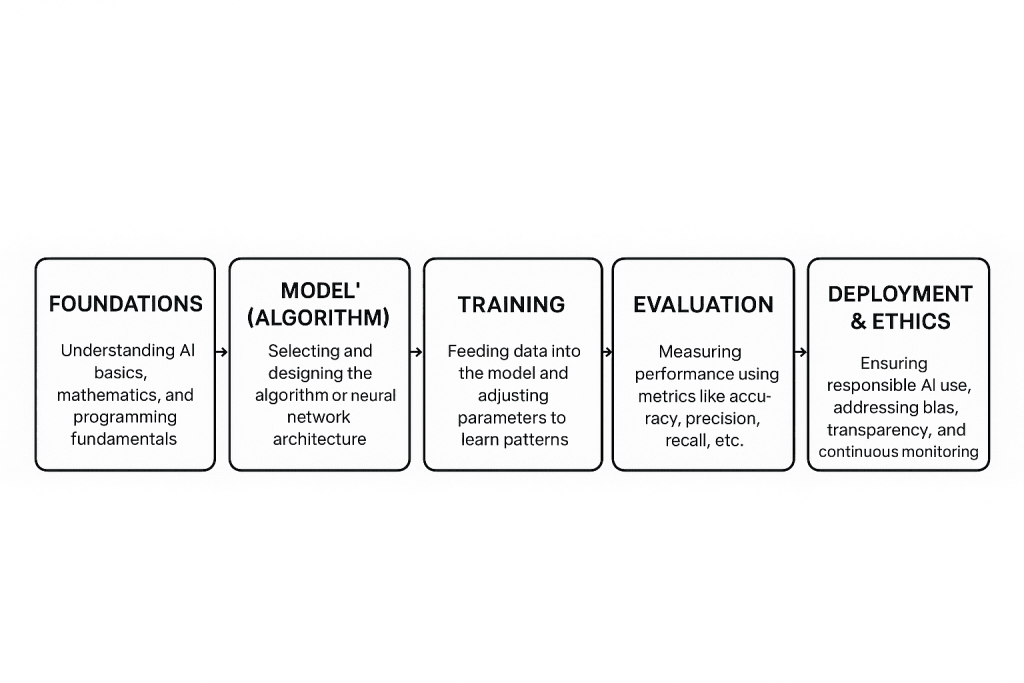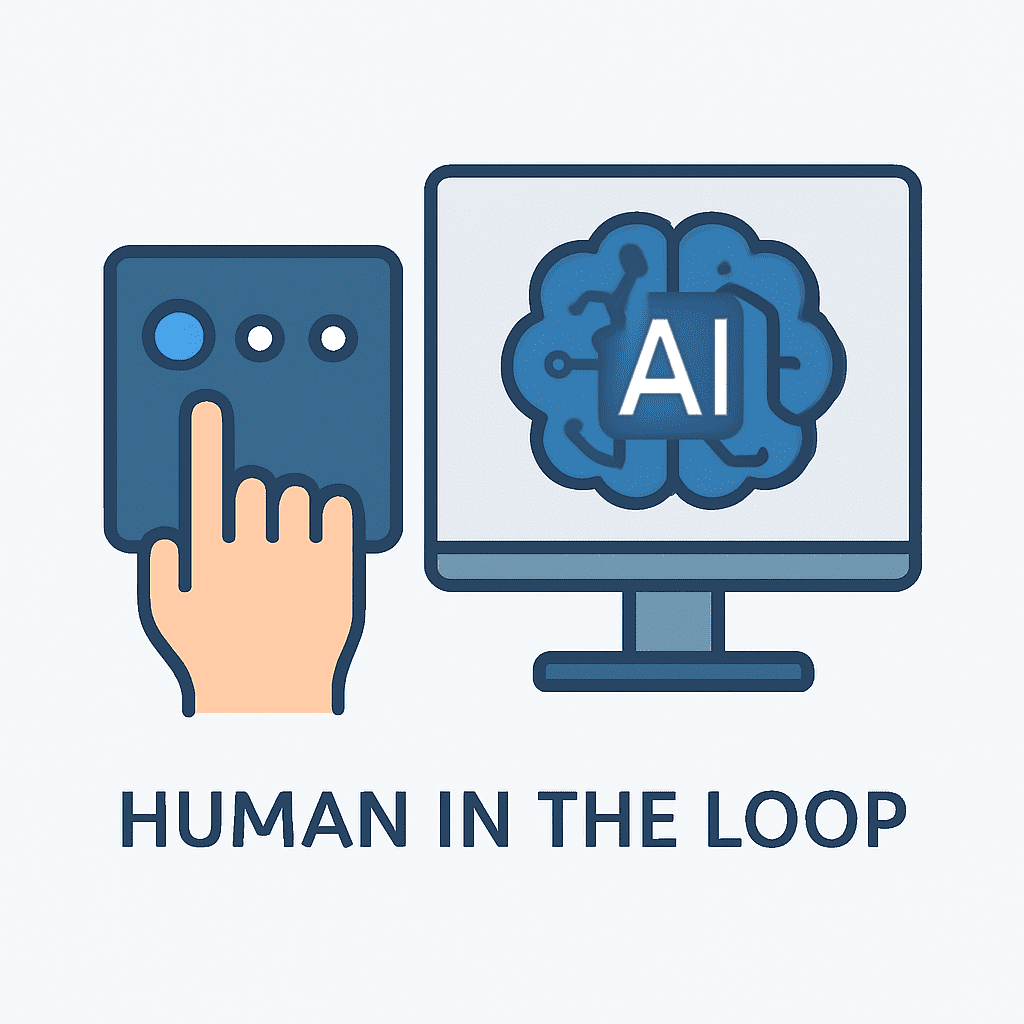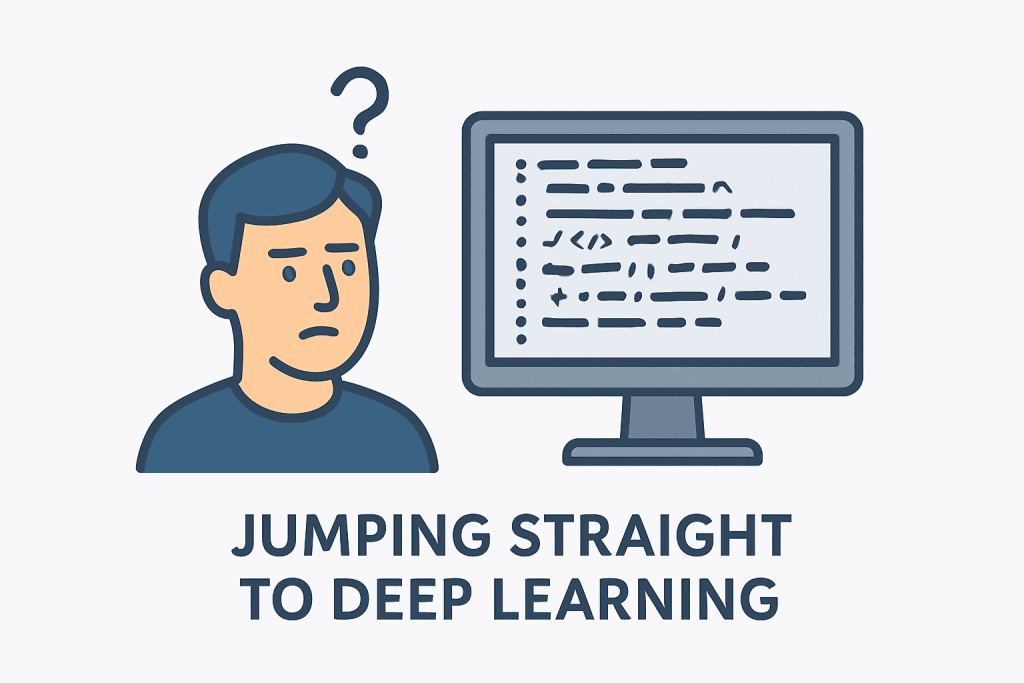The Artificial Intelligence revolution isn’t just coming; it’s already here, reshaping every industry from healthcare to finance. You know you need AI Training to stay relevant, but where do you start?
The path can feel overwhelming, like standing at the base of a massive mountain with no clear trail. Are you supposed to go back to college for a Computer Science degree, or can an online certificate get you where you need to be?

This comprehensive guide is your expert roadmap. We’ve distilled the complex world of AI skill development into a simple, actionable 7 Step Master Framework for AI Training, regardless of your current background.
By the time you’re done, you’ll know exactly which skills to focus on, the best resources to use, and how to apply your new knowledge to unlock incredible career opportunities. Let’s make you AI-ready.
Section 1: Establishing the Bedrock for AI Success
Before diving into complex algorithms, you need a solid foundation. Many people skip these prerequisites, which makes their later learning journey frustratingly difficult. Think of this as the non-negotiable groundwork for effective AI Training.
What are the prerequisites for AI training?
The absolute prerequisites for effective AI Training fall into two main categories: mathematical concepts and fundamental computational skills. You don’t need to be a math PhD, but a firm grasp of these areas will make machine learning concepts much easier to absorb.
For math, the core areas are Linear Algebra, Calculus, and Probability/Statistics. Linear Algebra helps you understand how data is represented and manipulated in models (vectors and matrices).
Calculus is essential for understanding how AI models learn and optimize themselves (gradient descent), and statistics is the backbone for interpreting data, measuring model performance, and understanding uncertainty.
On the computational side, a strong foundation in at least one key programming language is critical. Python is the industry standard due to its rich ecosystem of AI libraries like TensorFlow, PyTorch, and Scikit-learn.
You should be comfortable with basic data structures, control flow, and object-oriented programming concepts in Python before tackling dedicated AI courses.
Core Foundation: The Non-Technical Skills You Must Master
While the technical skills are crucial, don’t overlook the soft skills that make you a successful AI professional. These are often the hidden keys to getting hired and advancing your career.
- Curiosity and Adaptability: AI is complex and changes rapidly. You must have an insatiable thirst for learning new techniques and the adaptability to pivot as tools and frameworks evolve.
- Problem-Solving Mindset: At its heart, AI is about solving problems. You need to be able to deconstruct a real-world challenge into a machine-learnable task.
- Data Literacy: Beyond just coding, you must understand data provenance, quality, bias, and privacy concerns. This is crucial for responsible AI development.
Section 2: Building the Technical Core: Programming and Theory
With your foundation set, the next step in your AI Training is moving into the technical heart of the field: coding and core theoretical concepts like Machine Learning (ML) and Deep Learning (DL).
What subjects are required for AI?
The subjects required for a deep understanding of AI are multi-disciplinary, but the primary ones are Computer Science, Machine Learning, Deep Learning, and Natural Language Processing (NLP) or Computer Vision (CV), depending on your specialization.
Computer Science provides the general background in data structures, algorithms, and software engineering principles needed to build efficient AI systems.
Machine Learning and Deep Learning cover the specific algorithms that allow machines to learn from data, such as supervised learning, unsupervised learning, neural networks, and generative models.
If you are interested in chat systems or text analysis, NLP is key; if you are focused on autonomous vehicles or image recognition, Computer Vision is your required specialization.
The Machine Learning Specialization
Machine Learning is a critical subfield and a cornerstone of practical AI Training. It involves creating algorithms that can learn from data without being explicitly programmed.
The ML journey typically starts with basic models:
- Regression Models: Predicting continuous values (e.g., predicting house prices).
- Classification Models: Predicting discrete labels (e.g., classifying an email as spam or not spam).
- Clustering: Grouping similar data points without pre-existing labels (e.g., customer segmentation).
You’ll need hands-on experience with popular ML libraries like Scikit-learn in Python to apply these concepts to real-world datasets. This practical application cements the theoretical knowledge.

Section 3: Deep Dive into Deep Learning
Deep Learning, a powerful subset of Machine Learning, is responsible for the massive leaps in modern AI, including generative models and advanced perception systems. Your AI Training isn’t complete without a deep dive here.
Understanding Neural Networks
Deep Learning models use Neural Networks, which are essentially layers of interconnected nodes (neurons) that are highly effective at finding complex patterns in massive amounts of data, particularly images, video, and text.
The “deep” refers to the multiple hidden layers in the network structure.
Key deep learning architectures you must master include:
- Convolutional Neural Networks (CNNs): The go-to model for image and video analysis.
- Recurrent Neural Networks (RNNs) / LSTMs: Used for sequential data like time series or classic language modeling.
- Transformers: The architecture that powers modern Large Language Models (LLMs) and revolutionized NLP.
The primary tools for this level of AI training are the open-source frameworks TensorFlow and PyTorch. Mastery of either, or both, is a mark of a professional AI practitioner.
The New Gold Standard: Prompt Engineering Training
For non-engineers and business users, the most immediately impactful form of AI Training is Prompt Engineering. This is the art and science of writing effective instructions (prompts) to get the best possible output from a Generative AI model like Gemini, ChatGPT, or Claude.
Prompt Engineering is not a fleeting trend; it’s a core literacy skill. Learning how to craft clear, specific, and contextual prompts can increase your productivity dramatically, sometimes by a factor of 10x or more, saving you an average of 1.75 hours per day on routine tasks.
This skill is critical for all roles, from marketing to finance.
Section 4: Choosing Your Path: Degree vs. Certificate
A common question people have when beginning their AI Training journey is the debate between formal degrees and flexible online courses. The best choice depends entirely on your career goals, budget, and time commitment.
Which course is best for AI?
The “best” course for AI is the one that aligns with your desired career outcome and current skill level.
| Career Goal | Best Training Path | Key Courses/Degrees |
| AI Researcher/Engineer | Bachelor’s/Master’s in Computer Science, specialized AI degree, or a Master of Science in AI | Advanced University Programs (CMU, Harvard CS50, Illinois Tech), DeepLearning.AI Specializations |
| Data Scientist/Data Analyst | Specialized certificates and Professional Certifications | Google Career Certificates (Data Analytics), IBM Data Science Professional Certificate, Harvard Data Science courses |
| Non-Technical Professional (Manager, HR, Marketing) | Short, focused online courses on application and ethics | Google AI Essentials, DeepLearning.AI’s ‘AI For Everyone’, prompt engineering courses |
| Robotics/Autonomous Systems | Engineering Degree (Robotics, Electrical, Mechanical) with AI electives | Specific university engineering programs, hands-on TinyML courses |
For many, a blended approach works best: using free online courses (like those from Elements of AI or Coursera) to build foundational literacy, then investing in a Professional Certificate (like Google or AWS offerings) to gain field-specific, job-ready skills.

Section 5: The Actionable 7 Step AI Training Master Framework
To ensure your AI Training is efficient and goal-oriented, follow this proprietary framework. It moves you from a complete beginner to a specialized AI professional.
Step 1: Assess Your Current Skills and Define Your “Why”
Before doing anything, you need a learning plan.
Ask yourself: Are you a true beginner, or do you have a foundation in math and statistics? Are you pursuing a new technical career, or are you supplementing your current non-technical role? Your “why” determines your entire learning path.
A Data Analyst only needs to integrate AI tools; an aspiring ML Engineer needs to master the underlying math and code.
Step 2: Master the Prerequisite Trilogy
Dedicate time to establishing your foundation in Python, Linear Algebra, and Statistics. These three subjects are the keys that unlock all future advanced material. Focus on practical application rather than just theory—use Python to solve basic statistical problems.
Step 3: Complete a Foundational AI Literacy Course
Enroll in a high-quality introductory course. Programs like Elements of AI (free, no coding required) or DeepLearning.AI’s ‘AI For Everyone’ demystify the core concepts, terminology, and societal impact of AI.
This ensures you can confidently discuss AI in a business context.
Step 4: Specialize in a Core Discipline
Choose your focus: Machine Learning, Deep Learning, NLP, or Computer Vision. Start with a dedicated specialization, like a full Coursera or edX certificate program, that includes hands-on projects.
This is where you transition from theory to practice.
Step 5: Master Modern AI Tools and Generative Skills
No matter your track, integrate Prompt Engineering and practical use of LLMs (like Gemini or ChatGPT) into your daily workflow.
Learn how to use AI tools for productivity, research, and ideation. For technical users, this also involves learning frameworks like LangChain or Hugging Face.
Step 6: Build a Real-World Portfolio
Theory is useless without execution.
Your portfolio should include at least three end-to-end projects: data collection, model training, evaluation, and deployment. Examples could include a movie recommendation system, an image classification app, or a simple chatbot.
This showcases your skills to potential employers.
Step 7: Focus on Ethics, Bias, and Responsible Deployment
The final, essential step is to understand the ethical risks of AI. Learn about managing data bias, ensuring model explainability, and avoiding privacy breaches. This is where you become a valuable, responsible leader in the AI space.
[IMAGE 4: A flowchart of the 7-Step AI Training Master Framework, with each step clearly labelled]
Section 6: Advanced Specializations for Current Professionals
If you already have a background in technology or a highly data-driven field, your AI Training should focus on specialized upskilling. This is the fastest way to transition your career into a high-demand AI role.
How can I start learning AI?
If you already have a technical background, you can start learning AI by moving directly to specialized courses that leverage your existing skills.
For instance, a software developer can skip the basic Python and immediately jump into Deep Learning with PyTorch or TensorFlow.
A data analyst with strong SQL skills can focus on MLOps (Machine Learning Operations) courses to learn how to deploy and manage production-level AI models at scale.
If you are transitioning from a non-technical role like HR or Legal, start with application-focused courses like AI for Business or Responsible AI and Compliance. These allow you to leverage AI for process optimization and risk management without needing to write code.
Specialization Deep Dives
- Machine Learning Engineering (MLE): Focuses on the production side of AI. Skills include cloud platforms (AWS, Google Cloud, Azure), Docker/Kubernetes, and continuous integration/continuous deployment (CI/CD) pipelines for models.
- Computational Linguistics and NLP: This path is for those interested in language-based AI. It involves deep insights into human language complexity and training AI models for translation, summarization, and conversation.
- TinyML: A growing field focused on running simple ML models on small, low-power devices like microcontrollers. This is key for smart devices and the Internet of Things (IoT).
Corporate and Workplace AI Training
The demand for organization-wide AI Training is skyrocketing, especially with new regulations like the EU AI Act making employee AI literacy mandatory. Companies are focusing on two key areas:
- AI Literacy and Compliance: Ensuring every employee understands what AI is, how to use tools ethically, and the company’s internal guidelines for data use.
- Role-Specific Upskilling: Training departments like customer service, finance, and marketing on specific AI tools (e.g., using AI for fraud detection or automated content generation) to boost departmental productivity.

Section 7: Navigating Ethical Challenges in AI Training
As an expert in the field, you must understand that AI Training isn’t just about technical efficiency; it’s about ethical responsibility. There are also some challenges during AI training. The data used to train models fundamentally shapes the AI’s behavior, and bias is a major risk.
The Problem of Bias in Training Data
AI models are only as good as the data they are trained on. If the training data reflects existing societal biases—racial, gender, or otherwise—the AI system will not only replicate but often amplify those biases.
This is why human oversight and ethical training are paramount.
Example: A loan approval AI system trained predominantly on historical loan data from a particular demographic group might unfairly reject applicants from other groups, simply because it learned a biased pattern from the past.
The Role of the Human in the Loop
Even with the most advanced AI, the human in the loop is essential. You need to be the one managing the “virtual intern,” not being replaced by it. Your job is to:
- Review and Edit: Check AI-generated content or decisions for accuracy, relevance, and bias.
- Set Ethical Guidelines: Implement guardrails and policies for the beneficial and responsible use of AI within a team or organization.
- Ensure Explainability: Work towards making opaque models more transparent, which is a major concern in regulated industries like finance.
Ignoring the ethical dimension of your AI Training makes you a less valuable, and potentially dangerous, professional in the long run.

Common Mistakes to Avoid in Your AI Training Journey
Your journey to mastering AI will have pitfalls. Avoiding these common mistakes will save you time, money, and frustration.
- Jumping Straight to Deep Learning: Trying to learn advanced techniques like neural networks without a solid understanding of the underlying calculus and statistics is a recipe for failure. Master the fundamentals first.
- Focusing Only on Theory: Simply watching video lectures or reading textbooks isn’t enough. You must write code, complete hands-on labs, and build practical projects to cement your knowledge.
- Neglecting Domain Expertise: AI is a tool. You must combine your AI skills with knowledge of a specific domain (finance, healthcare, marketing) to make your expertise truly valuable.
- Ignoring Prompt Engineering: Thinking that prompt-writing is only for beginners is a huge mistake. Effective prompting is a high-leverage skill that instantly boosts productivity for everyone, even engineers.
- Underestimating Data Preparation: In reality, up to 80% of an AI project is spent on cleaning and preparing the data. Neglecting this crucial step in your training will lead to weak and ineffective models.
- Fearing the Math: Don’t let fear of concepts like derivatives and vectors stop you. Focus on the intuition behind the math—understanding why the concept is used—rather than simply memorizing formulas.
- Working in Isolation: Join online communities, find a study group, and collaborate on projects. AI is a team sport, and networking is crucial for learning and job searching.

Conclusion
AI Training is no longer a niche pursuit for researchers; it is a fundamental career requirement for nearly everyone.
By following the 7 Step Master Framework, you gain a comprehensive, structured path that moves you from foundational readiness to specialized expertise.
Start by defining your ‘why,’ build your base in Python and core math, and then choose a specialization that aligns with your professional goals.
Don’t wait to see how AI affects your job; proactively learn how to leverage it. Whether you commit to a full degree, a professional certificate, or a series of focused online courses, the key is action and consistent, project-based learning.
Mastering AI is a continuous journey, but with this roadmap, you are well-equipped to start now and dominate the future of your field.





Pingback: What is Machine Learning? Types, Pipeline, and Examples